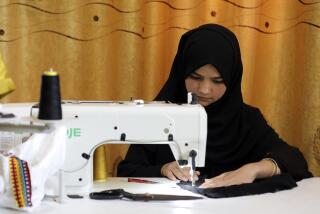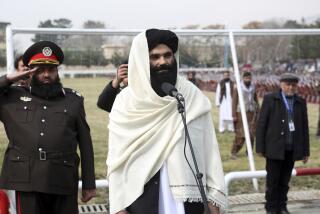The Glue That Holds Afghanistan
- Share via
KABUL, Afghanistan — In a country lacking a postal system, paved roads and a telephone network, the newly empowered authorities in this capital couldn’t exert their influence over the far-flung regions and rebellious warlords even if they tried.
But the patchwork of ethnic fiefdoms that, stitched together, form Afghanistan are beyond the reach of central rule for more reasons than poor logistics. Power-hungry regional kingpins and hidebound local traditions provide more comforting refuge to many Afghans than does the lofty concept of a united, multiethnic nation.
Still, there is some nationalist mortar that holds together the ethnic blocks and makes Afghanistan and its varied peoples one country. Unlike Europe’s failed multiethnic federations--the Yugoslav union of Balkan peoples and Czechoslovakia’s myriad Slavs--the Pushtuns, Tajiks, Uzbeks, Hazaras and others in this jigsaw puzzle of a nation take pride in their shared Afghan label.
Much as Americans can embrace being Southerners, New Yorkers, Angelenos or Kansans and still be moved by the sight of the Stars and Stripes, so, too, Afghans feel that more binds them than breaks them apart.
“I think the common Afghan man does see himself first as an Afghan. Do you think this country would still be around if the average Afghan man hadn’t been so much devoted to his home country and identity in these 23 years of disasters here?” incoming President Hamid Karzai replies when asked what unites his disparate people. “It’s precisely because of the strength of the common Afghan’s identity with it that keeps this country together.”
The past week’s loya jirga, a traditional gathering of regional delegates to decide the nation’s future, reflected this collective will to project Afghanistan and Afghans as a single entity, says Ashref Ghani, Karzai’s chief advisor and a delegate to the freewheeling forum.
Government officials acknowledge that central authority doesn’t yet reach much beyond Kabul. Ethnic clashes between rival chieftains in the north are impervious to appeals from officials here to unite in the daunting effort to rebuild a country largely reduced to rubble. The opium politics of the east still promise a better life for poppy farmers than the fledgling government in Kabul. And in the conservative south, especially around Kandahar, the ousted Taliban still enjoys much allegiance from Afghans who reject any notion of being ruled by leaders seen as Western puppets.
Although Karzai acknowledges that his reach remains limited, he blames the gaps in national reconciliation on the legacy of foreign interventions. The 1979-89 Soviet occupation forced the fiercely independent Afghans to wage armed resistance from the fringes, often with the aid, arms and counsel of self-interested neighbors and Soviet foes.
The invasions are over and the internecine fighting that has ravaged Afghanistan for the last decade also appears to be in check following a six-month power-sharing agreement worked out in Germany late last year.
The challenge now, as Karzai and his government colleagues see it, is to rapidly repair the damage so Afghans can again trade and travel, restoring the cultural and commercial bonds that made this country the heart of the fabled Silk Road.
Afghanistan, unlike European multiethnic states forced together by peace treaties, emerged to unite ethnic enclaves at the behest of the peoples guided by 18th century king Ahmad Shah Durani. Despite subsequent invasions and resistance, it has largely retained its original borders. United in their triumph of ousting intruders--first the British in the 19th century, then the Soviets and most recently the Taliban’s collaborators from Al Qaeda--Afghans tend to see their shared nationality as a geopolitical strength rather than a weakening of their cultural identity. But with so much destruction around them, rivalries and resentment can easily flare as aid is doled out disproportionately. It will take as much domestic initiative as foreign assistance to solidify Afghans’ commitment to living in a cohesive, multiethnic state.
“I always tell my Afghan friends that they can’t expect foreigners to love their country more than they do,” the U.S. special presidential envoy to Afghanistan, Zalmay Khalilzad, says of his former countrymen’s frequent appeals abroad for more peacekeeping troops to keep armed factions apart.
Key advisors to the central government insist that their dependence on foreign protection is temporary. Like the U.S. officials providing the training for the fledgling national army, Afghan leaders say the freshly minted domestic troops will gradually fill the security vacuums that have allowed regional warlords to thwart central rule.
International relief, though slow in arriving, also aims to enhance national cohesion through means such as mass media that can transcend self-interested local propaganda. The U.S. Agency for International Development, for instance, has distributed 30,000 shortwave radios to 11 provinces so foreign and national news reports can be received even in the most remote areas, says the agency’s Kabul representative, Craig Buck.
Even the foreign military presence in the country, the nearly 17,000 troops and special forces of the U.S.-led coalition against terrorism, are trying to wage a hearts-and-minds campaign to steer isolated peoples toward respect for central authority. In the volatile southern regions, where most U.S. forces are stationed, roving “psy-ops” vehicles blare broadcasts in the Pashto language explaining why Kabul has invited the anti-terrorism troops here and how ridding Afghanistan of Al Qaeda fighters will enhance security and allow the country to mend, says coalition spokesman Col. Roger King.
Other foreign observers of Afghanistan’s rapid transformation agree with the government’s contention that what divides Afghans isn’t ethnicity but their recent history of abuse. And what unites them, the observers say, is a desperate desire to recover the Afghanistan that existed before the Soviet invasion.
“Clearly, I think Afghans are committed to national unity. I think they are proud of being recognized again as part of the international community,” says Klaus-Peter Klaiber, the European Union’s special envoy here. “There is a very strong majority in favor of a successful political process. People want peace and unity in the place of division and war.”
At the loya jirga, common threads emerged that show nationwide bonds are re-forming, says Ghani, the Karzai advisor. Most notable, he says, was the unified voice of the women delegates pushing their male colleagues to put conflict behind them.
“This was probably the most open exchange between groups of political leaders and groups of citizens that this country has ever witnessed. It was truly exciting,” he says.
“The people of Afghanistan do recognize that those who are here represent the whole of Afghanistan--all communities, all points of view, the diaspora, refugees, internally displaced,” U.N. Special Representative Lakhdar Brahimi says of the loya jirga, which he describes as a positive experience in acting for the collective good.
Although Afghans and outsiders alike insist that this is a nation on the mend, their optimism is still shadowed by those wielding armed power in the provinces.
On the surface, some regions that make up this country of 27 million appear so divergent and dismissive of Kabul as to be independent countries in everything but name.
The regional governor in Jalalabad nurtures popular support with his defiance of central edicts to destroy the opium-producing poppy fields, pragmatically protecting the livelihoods of local farmers over the lives of drug-dependent Europeans.
In the volatile north, Uzbek and Tajik commanders who fought together against the Taliban now turn their guns on each other. And Karzai’s sole attempt at cooling the hot spots around Mazar-i-Sharif has, in the view of some observers, made the regional confrontations worse. Karzai alienated other minorities this spring by announcing that Gen. Abdul Rashid Dostum, an Uzbek, was his “special representative” in the north. Dostum is one of the most entrenched regional chieftains in the country, able to soak travelers and merchants for extortionate “taxes” that keep his army armed and ready for the next conflict.
The northern territories often function like separate countries. The Tajik-dominated Jamiat party controls the police force in Mazar. But as soon as visitors pass out of the city on its western edge, Dostum’s Russian-made tanks are waiting to greet them. The fiery general, who is an influential figure in the national Defense Ministry, also runs a virtual ministry of foreign affairs in Mazar, issuing visas and hosting local “embassies” from Iran and Turkey.
Although Kabul has disarmed under the presence of foreign peacekeepers, other cities and villages are still governed by the gun. Shepherds, street cleaners and civil servants alike tote their Kalashnikov rifles around with the easy indifference of Westerners carrying their lunch boxes and briefcases.
What separates Afghans in central regions like Bamian from the capital has more to do with recent history than with ethnic relations. The local militia, under regional strongman Mohammed Karim Khalili, directs the distribution of food aid and liaisons with U.S. Special Forces. Khalili’s fighters have the best new boots and equipment, while the local economy, which once prospered with a steady flow of international tourists visiting Bamian’s famed cliff-side Buddhas, faltered under the Taliban and now has virtually collapsed because the fundamentalists blew up the statues.
In Herat, the unchallenged political and military boss is Ismail Khan, a former moujahedeen commander who built a reputation as a fierce fighter against the Soviet occupation. Khan maintains a sizable private army and mingles regularly with U.S. Special Forces.
Many Afghans living under such resilient warlords feel that they are better off with the devils they know than risking a shift in allegiance to the unfamiliar faces in far-off Kabul.
Like many of the regional warlords, Khan says he supports the Karzai government, but he has yet to surrender any real power to the center.
Then there is Kandahar, Afghanistan’s second-largest city and wellspring of the Taliban. A sullen, defeated place hit hard by U.S. bombing, Kandahar is regularly papered with “night letters”--clandestine postings urging citizens to rise up against the Americans and the U.S.-backed local administration.
The list of errant regions is depressingly long, but some local chieftains have proved to be more puffed-up rhetoric than real threats to cohesion. When eastern renegade Bacha Khan warned on the eve of the loya jirga that failing to elect Mohammad Zaher Shah, the former monarch, as head of state would reignite civil war, his fiery admonitions were mostly ignored beyond his own remote region around the city of Khowst.
As Afghans turn to the absorbing business of rebuilding shattered houses, schools, roads, shops and desperately needed communications, the rewards of collective initiative might begin making themselves felt, reminding Afghans that a prosperous multiethnic nation must be more than the sum of its parts.
*
Times staff writers Jeffrey Gettleman, Paul Watson and David Zucchino in Afghanistan contributed to this report.
--- UNPUBLISHED NOTE ---
Beginning in stories published in 2006, the Afghan warlord Bacha Khan is identified as Pacha Khan Zadran. (Second reference is “Pacha Khan.”)
--- END NOTE ---
More to Read
Sign up for Essential California
The most important California stories and recommendations in your inbox every morning.
You may occasionally receive promotional content from the Los Angeles Times.














